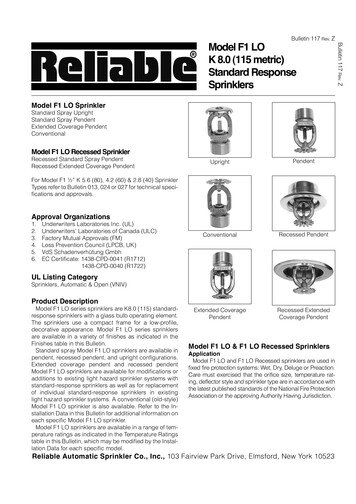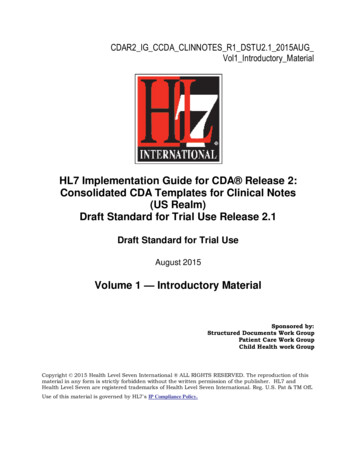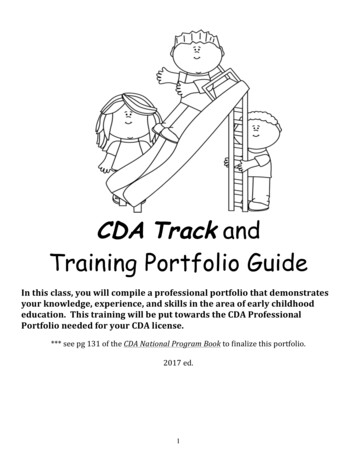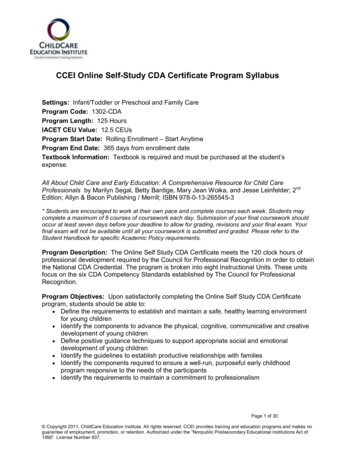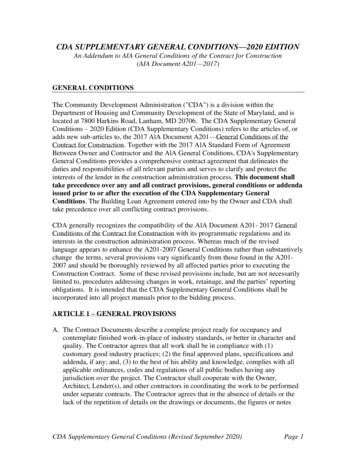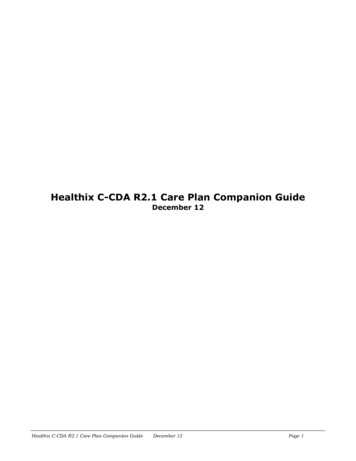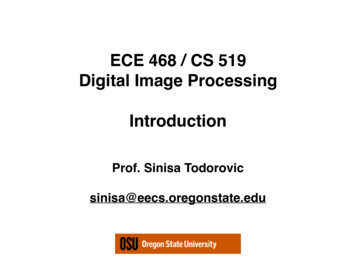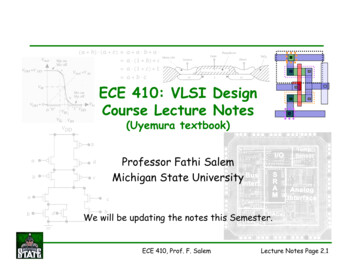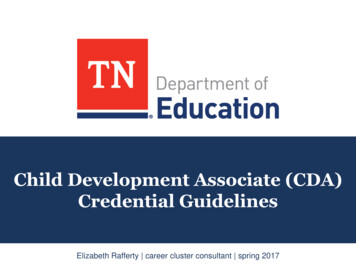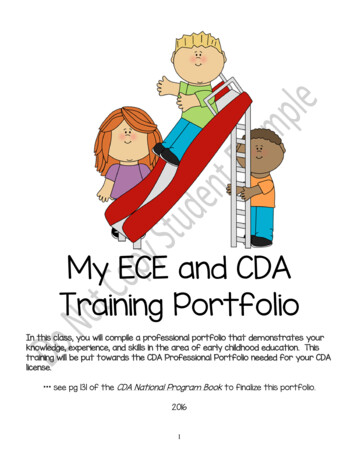
Transcription
My ECE and CDATraining PortfolioIn this class, you will compile a professional portfolio that demonstrates yourknowledge, experience, and skills in the area of early childhood education. Thistraining will be put towards the CDA Professional Portfolio needed for your CDAlicense.*** see pg 131 of the CDA National Program Book to finalize this portfolio.20161
Congratulations on beginning YOUR Child Development Associate (CDA)credentialing process!The following steps will help you to understand how you can obtain CDACredential.Step 1: PrepareStep 2: ApplyAny Time Before You Apply High School EducationProfessional Education – 120 clock hours,including 10 hours in each of the 8 CDASubject AreasProvide transcripts and certificates Within Three Years of Submitting Application Work Experience – 480 hours ofexperience working with children ages3-5Once the Council has approved your application andprocessed your payment, you must schedule andcomplete the following: Secure your director’s permissionfor your Verification Visit Submit the CDA application to theCouncil and pay the assessment fee Family QuestionnairesProfessional Portfolio (see next page)Step 3: Demonstrate Identify a CDA ProfessionalDevelopment Specialist and obtainher or his Identification NumberStep 4: EarnWithin Six Months of Submitting the Application Your Verification VisitBring your completed Professional Portfolioto your verification visit so that your PDSpecialist can review it.Your CDA Exam2Earn your CDA Credential andreceive an increase in pay.Step 5: Renew Renew your CDA Credential3 years from when you receivethe CDA license. Earn a second CDA Credential inanother area.
A. Fremont High School “Summary of My CDA Education” (Refer to CDA pg. 131& 132)To complete the CDA license within the high school Early Childhood EducationPathway (Child Development, ECE 1A, ECE 1B, and ECE 2), students need 480 labexperience hours and 120 total training hours, with at least 10 hours in eachsubject area and a C or better in the pathway classes.To this summary, attach school transcripts, state certificates, and officialdocuments proving education hours and any further education hours gained inother courses beyond the ECE pathway courses. ie: Adult Roles, HumanDevelopment, Sociology, Psychology, workshops, courses, etc.(See Attached Pages)The family questionnaire will be completed once all of the requirements foryour CDA education and experience hours have been met.*Sign up for the CDA class with the Center Director to get this portion ofyour portfolio completed and to finalize your CDA License.3
ECE CDA Portfolio GuideWriting a Competency Statement (CS)Using your own paper, prepare a written statement, approximately 225 words in length, on your ownteaching practices and beliefs. Refer to each unit’s competency statement instructions, the section formatbelow, and the sample that follows. WHY section: Introduce or briefly restate, in your own words, the Competency Statement. Describe why you think the competence is important for you as a caregiver, to the children, tothe families of the children, to other employees, and to the center or school. HOW section: Name the functional area. Restate or introduce the functional area’s definition in your own simplified words. Provide at least three specific examples that you can or will do to meet each of the listedfunctional area(s). See the CDA functional statement packet for example ideas.Competency Statement (CS III) Sample:I will support social and emotional development and provide positive guidance by developing a warm,positive, and trusting relationship with the children and their families because, I also feel that manychildren come from a home where it is unknown how to effectively guide and communicate with a child.This skill will be used and modeled within the center. Through these examples, the children and the familieswill learn what a strong emotional relationship and sense of self looks like and feels like, what positivesocial skills are and how to use them, and how to use positive guidance.Self: I will develop a warm, positive, supportive, and responsive relationship with each child, and helpeach child learn about and take pride in their own individual and cultural identity.My environment will be a place where children can develop their own individual talents through appropriateDAP play. I will use the children’s names and acknowledge their culture to build self-identity. Children willhave marked space to store their things and their work. I will encourage children to do those tasks thatthey can do.Social: I will help each child function effectively in the group, learn to express feelings, acquire socialskills, and make friends, and promotes mutual respect among children and adults.My environment will be a place where children can interact and play with each other. Props for curriculumareas will represent many cultural groups. I will encourage cooperation and respect between childrenrather than competition.Guidance: I will provide a supportive environment and uses effective strategies to promote children’sself-regulation and support acceptable behaviors, and effectively intervenes for children with persistentchallenging behaviors. The room environment, space, and materials will provide ample opportunities forappropriate playing and choices. I will verbally and non-verbally sincerely acknowledge when a child isexhibiting appropriate behaviors. I will stick to routine and schedules so children know what to expect. I willmodel appropriate and expected social skills. I will help children use their words rather than emotions.(320 words)Resource Collection (RC)Read the assignment instructions and collect or create the given resource materials.Competency Paragraph (CP)Write an extension paragraph (30 words) that reinforces the resources collected.4
Competency Statement ICompetencyStatement ITo establish andmaintain a safe,healthy learningenvironment&Resource Collection IFunctional Areas1. Safe2. Healthy3. LearningEnvironmentDefinitions1. Candidate provides a safe environment andteaches children safe practices to prevent andreduce injuries.2. Candidate provides an environment thatpromotes health and prevents illness, andteaches children about good nutrition andpractices that promote wellness.3. Candidate organizes and uses relationships, thephysical space, materials, daily schedule, androutines to create a secure, interesting, andenjoyable environment that promotesengagement, play, exploration, and learning of allchildren including children with disabilities andspecial needs.I will provide a safe environment and teach children safe practices toprevent and reduce injuries by creating rules and keeping to them. I willmake sure the none of the children are ever alone. While the kids areoutside there will always be at least 2 teachers with them and I will helpthe children remember how to be safe.I will provide an environment that promotes health and prevents illness,and teaches children about good nutrition and practices that promotewellness by making sure the kids help clean up after themselves. Bysanitizing all toys every week. By picking a good and healthy meal andletting the kids help make a serve it. I will also help them practice properhygiene.I will stay organized and use relationships, the physical space, materials,daily schedules, and routines to create a secure, interesting and enjoyableenvironment that promotes engagement, play, exploration, and learningof all children with disabilities and special needs by creating a schedule andsticking with it. By having the children have a say in the schedule. Bymaking sure the I have toys and equipment that interests the childrenand makes them want to play and have fun. While learning I will makesure that if a child with a disability or a special need is showed and knowsthat they can do anything!5
CP I-aSample Menu from RC I-2Reflect on the sample menu you wrote in Resource Collection (RC) I-2. Howdoes it reflect your commitment to children’s nutritional needs? What areits strengths and what would you change? (Files attached separately) CP I-bRoom EnvironmentReflect on the room environment in which you are currently providing careor where your verification visit observation will occur. How does the roomdesign reflect the way you believe young children learn best? If the roomwas not designed by you, what do you see as its strengths and/or whatwould you change? (Files attached separately) CP I-cWeekly Plan from RC I-3Reflect on the weekly plan you wrote in Resource Collection (RC) I-3. Howdoes this plan reflect your philosophy of what young children need on aweekly basis? If the plan was not designed by you, what do you see as itsstrengths and/or what would you change? (Files attached separately) RC I-1CS ICPR and First Aid TrainingInclude your valid and current certificate/cards of completion of (a) any first aid trainingcourse and (b) an infant/child (pediatric) CPR course offered by a nationally recognized trainingorganization (such as American Red Cross or the American heart Association) Online training isnot acceptable. Certification must have been within the past three years.Make a copy of your certificate and place it ON or IN FRONT OF this page.* When the CDA council does your evaluation, they will want to see your -original certificate.6
Competency Standard I: To establish and maintain a safe, healthy learningenvironment1.CDA CompetencyStandard ITo establish andmaintain a safelearning environment1.2.3.Functional AreasDefinitionsSafeHealthyLearningEnvironment1. Candidate provides a safe environment andteaches children safe practices to prevent andreduce injuries.2. Candidate provides an environment thatpromotes health and presents illness, andteaches children about good nutrition andpractices that promote wellness.3. Candidate organizes and uses relationships, anduses relationships, the physical space, materials,daily schedule, and routines to create a secure,interesting, and enjoyable environment thatpromotes engagement, play, exploration, andlearning of all children including children withdisabilities and special needs.I will provide a safe environment and teach children safe practices toprevent and reduce injuries by creating rules and keeping to them. I will makesure the none of the children are ever alone. While the kids are outside therewill always be at least 2 teachers with them and I will help the childrenremember how to be safe.I will provide an environment that promotes health and prevents illness, andteaches children about good nutrition and practices that promote wellness bymaking sure the kids help clean up after themselves. By sanitizing all toysevery week. By picking a good and healthy meal and letting the kids help makea serve it. I will also help them practice proper hygiene.I will stay organized and use relationships, the physical space, materials, dailyschedules, and routines to create a secure, interesting and enjoyableenvironment that promotes engagement, play, exploration, and learning of allchildren with disabilities and special needs by creating a schedule and stickingwith it. By having the children have a say in the schedule. By making sure the Ihave toys and equipment that interests the children and makes them want toplay and have fun. While learning I will make sure that if a child with a disabilityor a special need is showed and knows that they can do anything!7
RC I-2Weekly menuProvide a copy of one weekly menu for children. In order to complete therelated Competency Paragraph(CP I-a), the menu, ideally, should beone that you have participated in serving or designing.MondayBreakfastFrenchToastStrawberri(at least 2esfood itemsand MilkApple SlicesChickenNuggetsChickenAlfredoSweet RollCornBeetsSquashZucchiniMilkMilkMilkLunch(at least 3food itemsand adrink)SnackSpaghettiFish old FishWheatThinsRitzCrackersSlices ofcheeseBananaSlicesFruit JuiceRaisinsPear Slices(at least 1food itemand adrink)CheeseBurger W/BunMilkOrangeJuiceSaltinesFruit BarsWatermelon SlicesCheez-It’sWaterMilkMilkRC I-28
CS I aSample MenuReflect on the simple menu for Resource Collection 1-2 that you participated inserving and/or designing: if you designed the menu, how does it reflect yourcommitment to children’s nutritional needs? If you served the menu but did notdesign it, what are its strengths and/or what would you change?I choose this many because it is nutritional. I want the kids to be healthy butalso have yummy food many people think that if you are healthy the food isgross. You can have really yummy food and it can still be healthy I think thekids will enjoy this this many but their bodies will as well.CS I bRoom EnvironmentReflect on the room environment in which your Verification Visit Observation willoccur: How does the room design reflect the way you believe young childrenlearn best? If the room was not designed by you, what do you see as itsstrength and/or what would you change?I didn’t design the room. I think that the room is set up in a really good way. Ilike how there is a set place for circle time and I also like how it's very openthe only thing that's enclosed is the bathroom. Another thing I really like isthat we have certain centers like a reading nook, writing center and dramaticplay. I overall like the setup of the room and how it functions.9
CS I cWeekly Plan (from RC 1-3)Reflect on the weekly Plan you included in your Resource Collection 1-3. How doesthis plan reflect your philosophy of what young children need on a weekly basis?If the plan was not designed by you, what do you see as its strengths and/orwhat would you change?With this week activity outline I tried to make all of the activities fun andthat would get the child moving. I know that children need to be able tosocialize. Be creative and try new things weekly it will help them grow mentallyand emotionally.10
RC I-3Weekly Lesson PlansProvide a sample of a weekly plan that includes goals for children’s learningand development, a brief description of planned learning experiences, and alsoaccommodations for children with special needs. Indicate the age group(sIndicate the age group(s) for which the plan is intended.Weekly Theme The JungleAge Group 2-6Vocabulary Words Jungle ggsHuntObjective Goals (Why are you doing this“learn”.)Factual StatementsMonkeys live in a jungleBoa constrictor, Elephants, Jaguar alllive in the jungle.Animals leave tracks in the jungleVines and trees grow in the jungleJungles are wetactivity? You may not use the wordThe Children will be able to identify different jungle animals and describe whathappens in the jungle by using a variety of senses.Group Time(songs, stories,games, etc.)OutdoorActivities(1 idea each day)MondayTuesdaySong: 5littlemonkeysswinging ina treeMusicanddancewithscarves5 LittleGoing onMonkeysa safariswinging ina tree hleo kidsclimb tree11WednesdayThursdayFridayGoodnightMusic andGorilla- book Dance withscarvesWalkingthroughthe jungleJungleAnimalHabitatsAct liketheanimalsthat livein a jungleJungleanimalfreeze tagRCRCI-3I-3
Small groupactivities/centers(1 activity in eachcurriculum area)Special NeedsAccommodationsLanguage MusicArt&JungleJungleLiteracyanimalMasksLearn the groovenames of to thethe jungle music asanimalsyourandfavoritematch to junglepicturesanimalIf thechildrendon'tWrite 1 specialknowneed:what(Hearing, seeing,animalspeech, physicalmatchesstruggles, broken to whatleg/arm, etc.)name Iwill helpChoose 1previously written themactivity fromeach day andwrite how youwould adjust theactivity for theabove specialneed.If thechildrencan't seetheanimalsin thesafari iwill helpthemfindthem12If theChildrencan’t hearor see thebook i willallow themto movecloserScienceMathAnimals insandcountthe jungleanimalsIf someonehas abroken legfor jungleanimalfreeze tagthen I willhelp themtag peopleIf thechildcan’t seetheanimalsto countthem Iwill helpthem getcloser
B. Competency Statement IICompetencyStatement IITo advance physicaland intellectualcompetence& Resource Collection IIFunctional Areas4. Physical5. Cognitive6. Communication7. CreativeDefinitions4. Candidate uses a variety of developmentallyappropriate equipment, learning experiences, and teachingstrategies to promote the physical development (fineand gross motor) of all children.5. Candidate uses a variety of developmentallyappropriate learning experiences and teaching strategiesto promote curiosity, reasoning, and problem solving, andto lay the foundation for all later learning. Candidateimplements curriculum that promotes children’s learningof important mathematics, science, technology, socialstudies, and other content goals.6. Candidate uses a variety of developmentallyappropriate learning experiences and teaching strategiesto promote children’s language and early literacy learningand help them communicate their thoughts and feelingsverbally and nonverbally. Candidate helps dual-languagelearners make progress in understanding and speakingboth English and their home language.7. Candidate uses a variety of developmentallyappropriate learning experiences and teaching strategiesfor children to explore music, movement, and the visualarts, and to develop and express their creative abilities.I will promote the physical development (fine and gross motor) of allchildren by making sure that I plan activities that are not just letters,numbers, shapes etc. I will plan activities that have hem use their fine andgross motor skills.I will use a variety of developmentally appropriate learning experiences andteaching strategies to promote learning experiences and teaching strategiesto promote curiosity, reasoning, and problem solving, and to lay thefoundation for all later learning by providing activities and lessons thatstimulate their cognitive abilities.I will use a variety of developmentally appropriate learning experiences andteaching strategies to promote children's language and early literacy learningand help them communicate their thoughts and feelings verbally and nonverbally by speaking to the children with correct grammar and words. I willalso provide them with ways to learn more about literacy.I will use a variety of developmentally appropriate learning experiences andteaching strategies for children to explore music, movement, and the visualarts, and to develop and express their creative abilities by incorporatingmusic, movement and visual arts into our daily schedule.13
CS II aLearning Experiences (from RC II)Pick one of the nine learning experiences you chose for your Resource Collection II. How doesthis experience reflect your personal philosophy of how you support young children’s physicaldevelopment?I choose Resource II-5. The activity was to act out the song “ I’m Bringing Home a BabyBumblebee”. I had made little bumblebee stress balls. We then would act out what we weresaying. I made sure the actions were not to hard for the children to do.I know that the children need to develop physically. This activity helps me show how Isupport children's physical development. I think that it is important to have fun while youare learning and developing. I also know that children develop at different rates. So, I needto make sure I am flexible with my activities so I can change the actions to fit the child'sneeds.CS II bLearning Experiences (from RC II)Pick another one of the nine learning experiences you chose for your Resource Collection II.How does this experience reflect your personal philosophy of how you support young children’scognitive development?I choose Resource II-2. This activity was Alphabet Fishing. The children would catch a fish.Each fish had the lower and upper case of each letter. When the children would catch a fish iwould have them tell me the letter and sound it made. If they were not completely sure Iwould help them.This activity shows how I support children’s cognitive development by letting you know thatI know it is important that young children know their letters and the sounds they make. Iknow that they need to be challenged just a little bit so that they will be able to growcognitively. The activity also shows that I know that not all children will be at the same levelcognitively. It shows that I will help them if they don't understand.CS IICS II cLearning Experiences (from RC II)Pick a third learning experience you chose for your Resource Collection II. How doesthis experience reflect your personal philosophy of how you support young children’screative development?I choose Resource II-3. In this activity we were making a friendship puzzle. Eachchild colored one puzzle piece. I asked the to draw/write what friendship meant tothem.This activity helps show how I support children's creative development by havingthem color what they thought friendship meant. I didn’t tell them exactly what todraw/write, they had to use their creativity.14
CS II dCommunication and Language DevelopmentDescribe ways to promote the communication and language development among allchildren including dual language learners.Make sure that you always let the child share their thoughts. Also, make sure thatyou make it so that the child is comfortable to communicate with you. You could doactivities where the children need to communicate to do the activity. When you areworking with children that know more than one languages make sure that you staycalm and patient. You could maybe have the child teach you some of the otherlanguage that they know.RC II. Nine Learning ExperiencesCompile 9 learning experiences that cover each of the following curriculum areas below.RC II-1 Science/SensoryRC II-2 Language and LiteracyRC II-3 Creative ArtsRC II-4 Fine Motor (IndoorActivity)RC II-5 Gross Motor (OutdoorActivity)Music and MovementRC II-6 Self ConceptRC II-7 EmotionalSkills/RegulationRC II-8 Social SkillsRC II-9 MathematicsRC II*** These learning experiences can be, but are not limited to, activities you havealready written and used in your past Early Childhood pathway courses such asfrom Child Development, ECE 1A, ECE 1B, and ECE 2 or you can use a variety or15
resources, websites, and curriculum book ideas. It would be best to include avisual, a sample, or a picture of each activity (Google images is a great resourcefor this).Resource II-1 Science/SensoryActivity Name: Slimy SnakesAge Group: 2-6Objectives:The Children will explore colors and textures they see in their environmentALL Materials Needed:-Liquid Starch-Glitter Glue-Ziplock Bags-Portion Cups-Popsicle SticksDetailed Process and Teaching Strategies:-Have the children come over and talk about how snakes are slimy-Have the children pick what color of glitter glue they want-Have the children help you dump the liquid starch and glitter glue in theirportion cups-Start to have the children mix the two ingredients together with a popsiclestick-When it is most the way mixed, pour it into a ziplock bag-Have them work it with their hands until it is doneRational/ How is this activity Developmentally Appropriate?The children will be able to help make their slime and they will know what asnake kind of feels like16
Resource II-2 Language and LiteracyActivity Name: Alphabet FishingAge Group: 2-6Objectives:The children will recognize that there are upper and lower case letters by“fishing” fish that have the letters on themALL Materials Needed:-Fish with upper and lower case letters-Magnents-String-Fishing pole-Big Blue paper-Paper clipsDetailed Process and Teaching Strategies:-The children will come to my spot and I will ask them if any of them haveever been fishing-I will show them how to fish-When they catch a fish they will say the name of the letter of the fish andthe sound-Then they will through the fish back and the next child will go-If they don't know the letter on the fish I will help themHow is this activity Developmentally Appropriate?The children are pretending to fish, when they catch a fish they say theletter, they will learn the letters and their sounds17
Resource II-3 Creative ArtActivity Name: Friendship PuzzleAge Group: 2-6Objectives:The children will use a variety of media and materials to create drawings,pictures or other objectsALL Materials Needed:-Puzzle pieces-Color pencilsDetailed Process and Teaching Strategies:-Have the children come to your table and ask them questions aboutfriendship-Give them a piece of puzzle and tell them to draw or write what they thinkfriendship is-When they are done drawing have them talk about friendship-You can put the puzzle together or you can keep it apart os they can do itover and over againHow is this activity Developmentally Appropriate?I am giving the children space so they can use their imagination to draw18
Resource II-4 Fine Motor (Indoor Activity)Activity Name: Number/Color MatchAge Group: 2-6Objectives:The children will begin to count to 10 and 20 by ones by matching the numberstogether.ALL Materials Needed:Clothes pins with paint chips and numbers on the paint chips.Detailed Process and Teaching Strategies:-The children will come and sit at my table.-The children will then match the paint chip to the clothes pin with the correctcolor and number.-If the children need help I will help them match them together.How is this activity Developmentally Appropriate?The children will be able to match the colors and the number correctly.19
Resource II-5 Gross Motor (Outdoor Activity)Activity Name: Baby BumblebeeAge Group: 2-6Objectives:The children will exhibit and explore gross motor coordination by doing theactions to the song “I’m Bringing Home a Baby Bumblebee”ALL Materials Needed:-Bumblebee balloon-Song LyricsDetailed Process and Teaching Strategies:-I will have the children come to my station and I will get down on their level.-I will explain to the kids what we are going to do and give them each a bee.-We will then sing the song and do the actions with our balloon bees.How is this activity Developmentally Appropriate?The children will be able to act out what they are doing while learning a song.Resource II-6 Self-ConceptActivity Name: Flamingo SafariAge Group: 2-6Objectives:The children will use imitation or pretend play to learn new roles andrelationships by pretending to be on a safari.ALL Materials Needed:-Birds.-Flamingo facts.Detailed Process and Teaching Strategies:-I will have the children come and sit by me.-I will then explain how we are going on a safari to look for some flamingos.-We will then go and find the flamingos.How is this activity Developmentally Appropriate?The children will use their imagination to go on a flamingo safari.20
Resource II-7 Emotional Skills/ RegulationActivity Name: I Love You This MuchAge Group: 2-6Objectives:The children will express emotions and feelings by writing on the hands whythey love their mom.ALL Materials Needed:-Hands with paper accordion between them-Colored pencilsDetailed Process and Teaching Strategies:-I will have the hands ready to go before the activity-I will have the children come over and color/write a picture/ note for theirmom-I will talk to them about their moms while they color/write on the handsHow is this activity Developmentally Appropriate?The children will have a chance to express their feelings for their momsResource II-8 Social SkillsActivity Name: Building housesAge Group: 2-6Objectives:The children will develop skills to interact cooperatively with others by talkingabout what they are building.ALL Materials Needed:Lincoln logs.Detailed Process and Teaching Strategies:-I will sit on the floor with the children.-I will instruct the children to build a house or some other type of building.-While the children are building I will encourage them to talk to me/othersabout what they are building.How is this activity Developmentally Appropriate?The children will talk about what they are building and will be able to use theirsocial skills to talk to others.21
Resource II-9 MathematicsActivity Name: Color/number matchAge Group: 2-6Objectives:The children will begin to count to 10 and 20 by ones.ALL Materials Needed:-Clothes pins with paint chips that have numbers on it.Detailed Process and Teaching Strategies:-The children will come sit at my table.-The children will match the paint chip to the clothes pin with the correct colorand number.-If the children need help I will help them match it.How is this activity Developmentally Appropriate?This activity will let the children know colors and they will also be able to matchnumbers.Resource II-10 Music and MovementActivity Name: Wheels on the BusAge Group: 2-6Objectives:The children will learn several simple songs.ALL Materials Needed:Pictures of the different people that ride the bus.Detailed Process and Teaching Strategies:-The children will come sit at my table.-I will have one child choose what action we are going to be doing.-Then we will sing that version of the song.-Then another child will pick another action.How is this activity Developmentally Appropriate?22
The children will act how they think that person would act like on the bus. Theywill choose for themselves.23
RC III.Developmentally Appropriate Books1.Title of the Book: The Ugly DucklingAuthor: Retold by: DamdiPublisher: 1-56987-509Copyright date: 1989Topic:Having high self-esteemShort Summary of the age-appropriate children’s book:In this book you learnt that everyone is different. Nobody is the same. Itdoesn't matter what you look like on the outside, it only matters what's onthe inside.What area, topic, or challenges of a child’s life or challenges does this booksupport and explain how:It helps with self-esteem, believing in yourse
Training Portfolio In this class, you will compile a professional portfolio that demonstrates your knowledge, experience, and skills in the area of early childhood education. This training will be put towards the CDA Professional Portfolio needed for your CDA license. *** see pg 131 of the CDA National Program Book to finalize this portfolio. 2016
